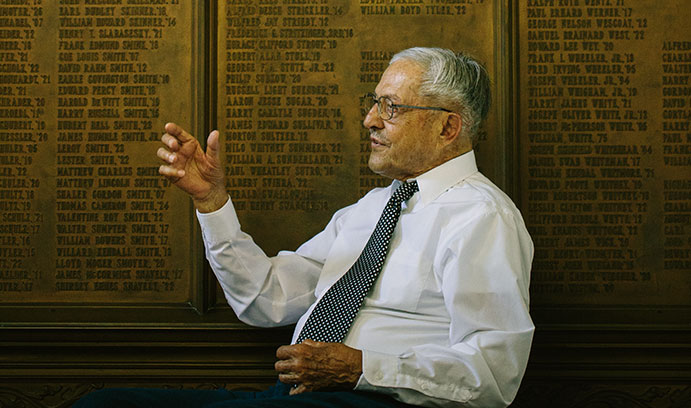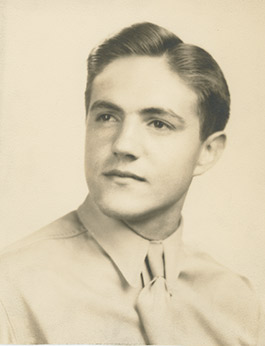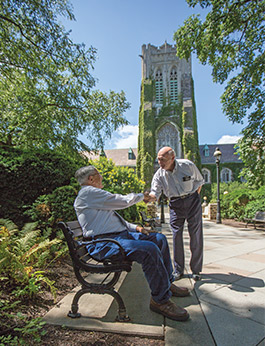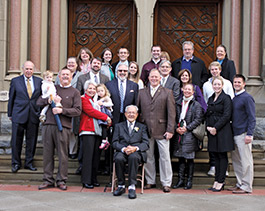Life interrupted

In 1946, Michael ‘Mickey’ Yonkovig set his sights on an engineering degree at Lehigh. Nearly 70 years after dropping out, he searched for a way to set things right.
Life seemed full of promise when Michael M. “Mickey” Yonkovig enrolled at Lehigh in the spring semester of 1946.
Yonkovig had just received an honorary discharge from the United States Army Air Corps after flying 23 missions in the Pacific Theater of World War II. Three years earlier, he had graduated seventh in his class at Shamokin High School in eastern Pennsylvania. He was president of his senior class, drum major and clarinetist in the marching band, and the only member of the basketball team recommended by his coach to attend Lehigh.
Now a 20-year-old Lehigh freshman, Yonkovig took up residence in Richards House, set his sights on an engineering degree and began attending classes. But he struggled horribly. For the first time in his life, he could not focus or remember details. Even the names of his closest friends eluded him. After two and a half years, Yonkovig dropped out of Lehigh. He took a job in a meat-packing plant, married and had three children. He held a series of jobs until, in 1963, he became a partner and part-owner of Shamokin Packing Co. He retired in 1986.
Throughout his life, Lehigh seldom left Yonkovig’s mind. Two thoughts stayed with him. In failing, he told himself, he had let Lehigh down and let himself down. But from the fog of forgetfulness, lessons he had learned at Lehigh re-emerged and helped him succeed later in life. Meanwhile, Yonkovig searched for a way to set right what he had been unable to finish so many years earlier.
***
“LIFE IS BEAUTY FULL” reads a large poster in the living room of Yonkovig’s home in Kulpmont, a few miles from Shamokin. Yonkovig is 91 years old now and twice a widower. His shoulders are slightly hunched and he uses a walker. But his head is full of mostly white hair, he still possesses a rich baritone voice, and when he smiles, which is often, the young man in the U.S. Army Air Corps uniform emerges.
Yonkovig grew up in a house three blocks from the Ukrainian Catholic Church that his father and grandfather had helped build. Family, friends and music were also central to his childhood.
“It was a beautiful time to grow up. We had fun on the corner, games outside, playing hide and seek. After Sunday mass, for one year, a man who had played in John Philip Sousa’s band came to give us clarinet lessons. And Fred Waring and the Pennsylvanians—we used to sit in the front row of his concerts at a resort in the Delaware Water Gap.”
Yonkovig was still in high school when he signed up for the Army Air Corps at the urging of his older brother, Danny, who was training to be a pilot. On Aug. 26, 1943, Mickey’s 18th birthday, Danny was killed, the single victim of a lightning attack, in North Carolina.
Yonkovig entered the Air Corps in November and was sent to Boca Raton, Florida, for radio school. He excelled and was one of only 13 in his class of 200 who were chosen to go further and attend radar school. He took additional training in Seattle and Hawaii before shipping off to the Pacific.
He thought frequently of his mother and father, grieving over Danny’s death.
“I was worried about my parents,” he says. “So I went to a USO radio studio. I recorded some songs of me singing to make my parents happy. I still have the original vinyl recording.”
In the Pacific, Yonkovig was assigned as radar operator to the 867th Bombardment Squadron of the 494th Bombardment Group. Of the 23 missions he flew, 13 were over Japan.
“Our job,” he says, “was to hit all the small [Japanese] airfields to prevent their fighter planes from attacking our B-29s.”
Yonkovig kept a log of each mission he flew, recording the outcome, the plane’s altitude, the weather conditions and other details. For his first mission, over Iwo Jima on Feb. 7, 1945, he wrote: “Bad weather, snow and sleet, lost engine over target and had to throw out all ammunitions.”
On another mission, he says, “the plane flying 30 feet behind us was hit directly [by enemy fire]. Its wing flew off and everyone on board was killed.”
On Aug. 5, 1945, Yonkovig’s plane dropped propaganda leaflets over the city of Takimizu on the island of Kyushu. On Aug. 7, Yonkovig flew over Hiroshima and saw the destruction caused the previous day by the first atomic bomb. Two days later, he flew over Nagasaki when the second bomb was dropped.
“We were flying at 10,000 feet elevation, 20,000 feet below the plane carrying the bomb,” Yonkovig says. “I saw Hiroshima and Nagasaki both. I tried to blank out the experiences. They still come back to me. At Nagasaki, I saw stuff fluttering down and thought, ‘Oh, my goodness! Within seconds, all those people just became dust.’ But I would not be here if [we hadn’t dropped the bomb]. The Japanese would never have surrendered.”
Yonkovig received his honorable discharge in November, returned home and dove right into Lehigh. “I signed up for electrical engineering because I had been a radar and a radio operator. I really wanted to be able to build things. But when I tried to study—well, I’ve talked about it a lot with my son [Michael J. Yonkovig, a psychologist], and he believes I definitely had PTSD.”
Post-traumatic stress disorder did not enter the medical lexicon until the early 1970s. In the 1940s, says Yonkovig, it was recognized in some World War II veterans, but not all.
“Some of the soldiers who had PTSD were wild and out of control. Me, I looked good. I kept it in. But looking good and having it on your mind are two different things.
“No one knew how to help me. There weren’t any counselors or teachers who said, ‘Wait one or two years to use your G.I. Bill.’ I thought I had to use it right away. But I couldn’t study or memorize anything.”
Yonkovig’s memories of his Lehigh years are spotty. He cannot recall the names of any of his professors and he remembers only one fellow student—William G. Humphreys ’49. He enjoyed attending chapel services and hearing the choir perform in Packer Memorial Church.
“The main thing that I do remember,” he says, “is walking up and down the hills. I loved the campus and just being a part of it and knowing I had been accepted. In those years, very few kids ever got that chance.”
Yonkovig kept records of the grades he earned and he recites them from memory: “In two and a half years, I got two B’s, four C’s, 13 D’s and 13 F’s.” The B’s were in an art class and a civil engineering class. Yonkovig still has his art sketchbook and a textbook titled Problems in Descriptive Geometry for Engineers. “I loved that art class. I did five or six drawings in that class, and I have these in my sketch book. One of them is a painting of a student named Richard Ashbrook. There’s another portrait but the person isn’t named. And there’s one portrait that just says ‘Mrs. Caraway.’”
After he started his first meat-packing job, Yonkovig says, his memory gradually returned.
“Working with my hands, I started to relax. I went to a meat-packing school in Toledo and I realized, ‘I can do this.’ The hardest thing for me was to study and remember things. But little by little, I got better.”
As he advanced in the industry, Yonkovig relied more and more on some of the skills he had learned—and forgotten—at Lehigh. He drew up the plans for a large addition, helping the Shamokin Packing Co. obtain federal certification for interstate sales. As a result, Shamokin grew into a major company with 140 workers and a fleet of tractor-trailers delivering meat products to every city in the northeastern U.S.
“I was at the plant sometimes for 24 hours,” Yonkovig recalls. “I knew my background was engineering, and I wasn’t afraid to handle any job. Lehigh helped me a lot; I can’t thank it enough.”
Yonkovig spoke frequently of Lehigh to his children, but kept his distance from his old school for more than 60 years.
“Since I was a student, I drove there once or twice, I’m not sure if I would…I just didn’t feel comfortable, I thought, because I made all those bad marks, something in my mind…”
In July 2013, his son Michael wrote to former Lehigh President Alice P. Gast to ask if Lehigh could help his father “reconnect with Lehigh University in a new way.” “My father,” Michael wrote, “always talked to me positively about the university yet always felt a loss, a pang of regret, about his time there. Any gesture would be appreciated.” Gast wrote back expressing gratitude for Mickey Yonkovig’s military service. She asked Robert W. Wolfenden, former associate vice president for alumni relations in the office of advancement, to present Yonkovig with a Lehigh University Alumni Association certificate.
On Nov. 22, 2013, in Packer Memorial Church, Gast presented a Certificate of Attendance to Yonkovig. Two dozen members of his family attended the ceremony.
“For his participation in student life between the spring of 1946 and spring of 1948, for his service to his country, and for always keeping Lehigh so close to his heart,” the certificate read, “we are proud to call Mickey Yonkovig a member of the Lehigh family.”
The certificate was signed by Wolfenden and Michael J. Connor ’80, the president of the Lehigh Alumni Association Board of Directors.
Last summer, Yonkovig visited his old dorm, Richards House, for the first time in more than 65 years. He walked slowly to the corner room on the ground floor and sat for several minutes on the edge of the bed.
“I’ve got a lot of history,” he said finally. “I try to look at everything in a positive way, to stay as positive as possible and don’t get stressed.
“To me, to have this tie once again with Lehigh University, it means more than I can say.”
Photography by Christa Neu
Posted on:




